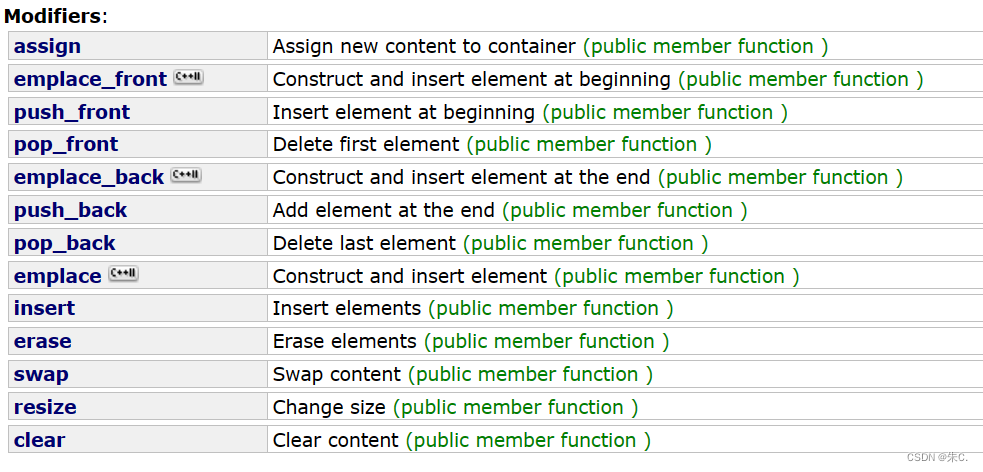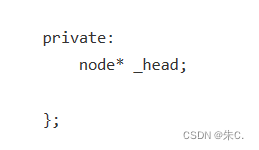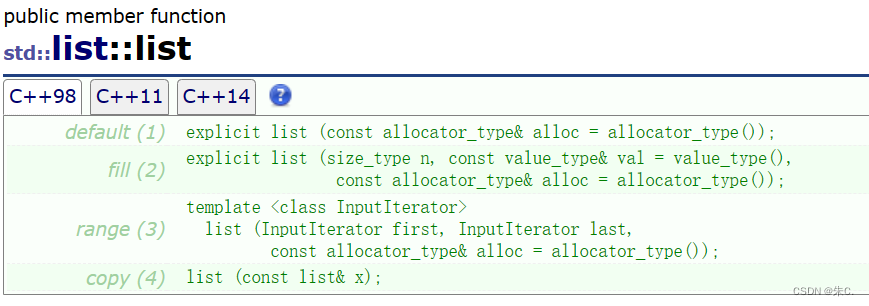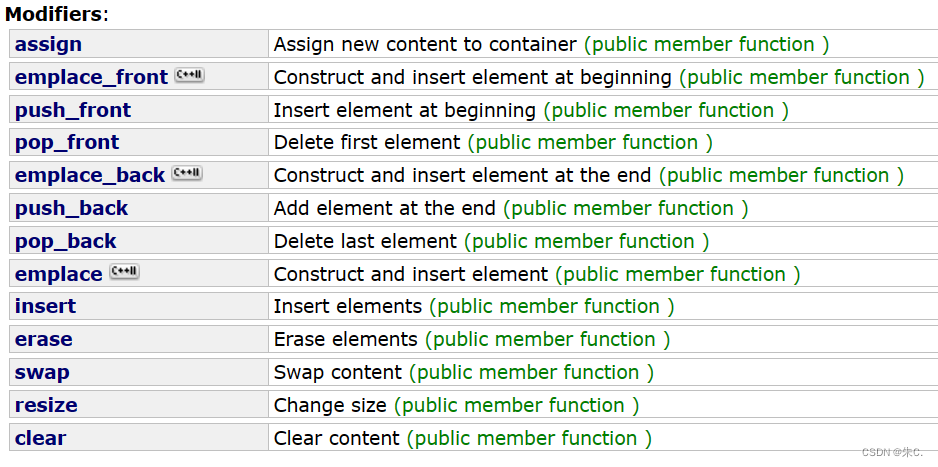有了之前两个STL中容器和数据结构初阶链表的学习基础,下面list的学习将会简单很多。
目录
(一)list的介绍和使用
(1)list的介绍
- 1. list是可以在常数范围内在任意位置进行插入和删除的序列式容器,并且该容器可以前后双向迭代。
- 2. list的底层是双向链表结构,双向链表中每个元素存储在互不相关的独立节点中,在节点中通过指针指向其前一个元素和后一个元素。
- 3. list与forward_list非常相似:最主要的不同在于forward_list是单链表,只能朝前迭代,已让其更简单高效。
- 4. 与其他的序列式容器相比(array,vector,deque),list通常在任意位置进行插入、移除元素的执行效率更好。
- 5. 与其他序列式容器相比,list和forward_list最大的缺陷是不支持任意位置的随机访问,比如:要访问list的第6个元素,必须从已知的位置(比如头部或者尾部)迭代到该位置,在这段位置上迭代需要线性的时间开销;list还需要一些额外的空间,以保存每个节点的相关联信息(对于存储类型较小元素的大list来说可能是一个重要的因素)
(2)list的使用
有了前面两章的学习,list的使用我们还是查文档
![]()
首先,几个默认成员函数如下,我们着重看构造函数


构造函数分为上面四种用法,我们用代码来使用操作:
void TestList1()
{
list<int> l1; // 构造空的l1
list<int> l2(4, 100); // l2中放4个值为100的元素
list<int> l3(l2.begin(), l2.end()); // 用l2的[begin(), end())左闭右开的区间构造l3
list<int> l4(l3); // 用l3拷贝构造l4
// 以数组为迭代器区间构造l5
int array[] = { 16,2,77,29 };
list<int> l5(array, array + sizeof(array) / sizeof(int));
// 列表格式初始化C++11
list<int> l6{ 1,2,3,4,5 };
// 用迭代器方式打印l5中的元素
list<int>::iterator it = l5.begin();
while (it != l5.end())
{
cout << *it << " ";
++it;
}
cout << endl;
// C++11范围for的方式遍历
for (auto& e : l5)
cout << e << " ";
cout << endl;
}=================================================================
list的迭代器操作的接口如下:


迭代器的使用和string/vector没有区别(其实底层实现改变了,我们后面模拟实现会详解)
void TestList2()
{
int array[] = { 1, 2, 3, 4, 5, 6, 7, 8, 9, 0 };
list<int> l(array, array + sizeof(array) / sizeof(array[0]));
// 使用正向迭代器正向list中的元素
// list<int>::iterator it = l.begin(); // C++98中语法
auto it = l.begin(); // C++11之后推荐写法
while (it != l.end())
{
cout << *it << " ";
++it;
}
cout << endl;
// 使用反向迭代器逆向打印list中的元素
// list<int>::reverse_iterator rit = l.rbegin();
auto rit = l.rbegin();
while (rit != l.rend())
{
cout << *rit << " ";
++rit;
}
cout << endl;
}
=================================================================

这两个主要返回头尾结点值的引用


关于容量的接口主要是empty判空和size返回大小的函数
=================================================================
修改类接口(增删查改等)

样例代码:
// list插入和删除
// push_back/pop_back/push_front/pop_front
void TestList3()
{
int array[] = { 1, 2, 3 };
list<int> L(array, array + sizeof(array) / sizeof(array[0]));
// 在list的尾部插入4,头部插入0
L.push_back(4);
L.push_front(0);
PrintList(L);
// 删除list尾部节点和头部节点
L.pop_back();
L.pop_front();
PrintList(L);
}
// insert /erase
void TestList4()
{
int array1[] = { 1, 2, 3 };
list<int> L(array1, array1 + sizeof(array1) / sizeof(array1[0]));
// 获取链表中第二个节点
auto pos = ++L.begin();
cout << *pos << endl;
// 在pos前插入值为4的元素
L.insert(pos, 4);
PrintList(L);
// 在pos前插入5个值为5的元素
L.insert(pos, 5, 5);
PrintList(L);
// 在pos前插入[v.begin(), v.end)区间中的元素
vector<int> v{ 7, 8, 9 };
L.insert(pos, v.begin(), v.end());
PrintList(L);
// 删除pos位置上的元素
L.erase(pos);
PrintList(L);
// 删除list中[begin, end)区间中的元素,即删除list中的所有元素
L.erase(L.begin(), L.end());
PrintList(L);
}
// resize/swap/clear
void TestList5()
{
// 用数组来构造list
int array1[] = { 1, 2, 3 };
list<int> l1(array1, array1 + sizeof(array1) / sizeof(array1[0]));
PrintList(l1);
// 交换l1和l2中的元素
list<int> l2;
l1.swap(l2);
PrintList(l1);
PrintList(l2);
// 将l2中的元素清空
l2.clear();
cout << l2.size() << endl;
}(二)模拟实现list
文章开头介绍List就说过,list其实是双向链表。所以我们先定义每一个结点的构成——由指向前后的两个指针和存放的数据构成。

而链表类只需要一个成员就可以了————哨兵位的头结点。有了它,其实就等于一下子知道了头结点和尾结点了。

由于构造函数中有迭代器初始化,所以我们还是先看迭代器的模拟实现。
(1)迭代器的模拟实现
迭代器分为下面两种类型:
- 1、迭代器要么就是原生指针
- 2、迭代器要么就是自定义类型对原生指针的封装,模拟指针的行为
list的各个结点显然不是在同一块连续的空间上的,所以这里我们需要模拟实现第二种。原生指针的行为无非就是几类:解引用*,取地址->,++,--,!=,==等,所以我们把迭代器需要用到的几种指针的行为模拟实现即可。
这里有一点注意的是:
下面模板参数中Ref和Ptr的作用是什么?
- 迭代器类型有两种:iterator和const_iterator,解引用*操作后返回_data的值,若是const_iterator迭代器返回的是const类型的数据,所以用模板参数Ref来统一实现*操作,当然,不用Ref模板参数也可以,但是要写一个重载函数返回const类型的数据,这样未免显得代码有点冗余,库里面的iterator也是这样使用模板参数的。Ptr也是同理。
template<class T,class Ref,class Ptr>
struct __list_iterator
{
typedef list_node<T> node;
typedef __list_iterator<T, Ref,Ptr> self;
node* _node;
__list_iterator(node* n)
:_node(n)
{}
Ref operator*()
{
return _node->_data;
}
Ptr operator->()
{
return &_node-> _data;
}
self& operator++()
{
_node = _node->_next;
return *this;
}
self operator++(int)
{
self tmp(*this);
_node = _node->_next;
return tmp;
}
self& operator--()
{
_node = _node->_prev;
return *this;
}
self operator--(int)
{
self tmp(*this);
_node = _node->_prev;
return tmp;
}
bool operator!=(const self& s)
{
return _node != s._node;
}
bool operator==(const self& s)
{
return _node == s._node;
}
};
迭代器的几个成员函数:
iterator begin()
{
//iterator it(_head->_next);
//return it;
return iterator(_head->_next);
}
const_iterator begin() const
{
return const_iterator(_head->_next);
}
iterator end()
{
return iterator(_head);
}
const_iterator end() const
{
//iterator it(_head->_next);
//return it;
return const_iterator(_head);
}
(2)构造函数的模拟实现
我们查阅文档,构造函数有下面几种类型:

基本构造函数:
void empty_Init()
{
_head = new node;
_head->_next = _head;
_head->_prev = _head;
}
list()
{
empty_Init();
}迭代器构造:
template <class iterator>
list(iterator first, iterator last)
{
empty_Init();
while (first != last)
{
push_back(*first);
++first;
}
}拷贝构造(精简写法):
先自己初始化,然后把一个tmp临时变量利用迭代器构造,最后自己“渔翁得利”,直接把tmp的构造成果拿来。
void swap(list<T>& tmp)
{
std::swap(_head, tmp._head);
}
list(const list<T>& it)
{
empty_Init();
list<T> tmp(it.begin(), it.end());
swap(tmp);
}赋值重载=:
list<T>& operator=(list<T> lt)
{
swap(lt);
return *this;
}析构函数:
~list()
{
clear();
delete _head;
_head = nullptr;
}(3)修改类型的成员函数

这里重点模拟实现几种常用的。
insert和erase:
他们两的实现在链表的数据结构中其实讲过。
void insert(iterator pos, const T& x)
{
node* cur = pos._node;
node* prev = pos._node->_prev;
node* new_node = new node(x);
prev->_next = new_node;
new_node->_prev = prev;
new_node->_next = cur;
cur->_prev = new_node;
}
iterator erase(iterator pos)
{
assert(pos != end());
node* prev = pos._node->_prev;
node* next = pos._node->_next;
prev->_next = next;
next->_prev = prev;
delete pos._node;
return iterator(next);
/*assert(pos != end());
node* cur = pos._node;
node* prev = pos._node->_prev;
node* next = pos._node->_next;
prev->_next = next;
next->_prev = prev;
delete cur;
return iterator(next);*/
}尾插(删)、头插(删):
只需要调用insert和erase在特殊位置进行操作:
void push_back(const T& x)
{
insert(end(), x);
}
void push_front(const T& x)
{
insert(begin(), x);
}
void pop_back()
{
erase(--end());
}
void pop_front()
{
erase(begin());
}
void clear()
{
iterator it = begin();
while (it != end())
{
erase(it++);
}
}(4)完整的代码实现
最后附完整代码实现及应用测试:
#pragma once
#include<assert.h>
#include<iostream>
using namespace std;
namespace zc
{
template<class T>
struct list_node
{
list_node<T>* _next;
list_node<T>* _prev;
T _data;
list_node(const T& data = T())
:
_next(nullptr),
_prev(nullptr),
_data(data)
{}
};
// 1、迭代器要么就是原生指针
// 2、迭代器要么就是自定义类型对原生指针的封装,模拟指针的行为
template<class T,class Ref,class Ptr>
struct __list_iterator
{
typedef list_node<T> node;
typedef __list_iterator<T, Ref,Ptr> self;
node* _node;
__list_iterator(node* n)
:_node(n)
{}
Ref operator*()
{
return _node->_data;
}
Ptr operator->()
{
return &_node-> _data;
}
self& operator++()
{
_node = _node->_next;
return *this;
}
self operator++(int)
{
self tmp(*this);
_node = _node->_next;
return tmp;
}
self& operator--()
{
_node = _node->_prev;
return *this;
}
self operator--(int)
{
self tmp(*this);
_node = _node->_prev;
return tmp;
}
bool operator!=(const self& s)
{
return _node != s._node;
}
bool operator==(const self& s)
{
return _node == s._node;
}
};
template<class T>
class list
{
typedef list_node<T> node;
public:
typedef __list_iterator<T, T&, T*> iterator;
typedef __list_iterator<T, const T&, const T*> const_iterator;
void empty_Init()
{
_head = new node;
_head->_next = _head;
_head->_prev = _head;
}
list()
{
empty_Init();
}
template <class iterator>
list(iterator first, iterator last)
{
empty_Init();
while (first != last)
{
push_back(*first);
++first;
}
}
void swap(list<T>& tmp)
{
std::swap(_head, tmp._head);
}
list(const list<T>& it)
{
empty_Init();
list<T> tmp(it.begin(), it.end());
swap(tmp);
}
list<T>& operator=(list<T> lt)
{
swap(lt);
return *this;
}
iterator begin()
{
//iterator it(_head->_next);
//return it;
return iterator(_head->_next);
}
const_iterator begin() const
{
return const_iterator(_head->_next);
}
iterator end()
{
return iterator(_head);
}
const_iterator end() const
{
//iterator it(_head->_next);
//return it;
return const_iterator(_head);
}
void insert(iterator pos, const T& x)
{
node* cur = pos._node;
node* prev = pos._node->_prev;
node* new_node = new node(x);
prev->_next = new_node;
new_node->_prev = prev;
new_node->_next = cur;
cur->_prev = new_node;
}
iterator erase(iterator pos)
{
assert(pos != end());
node* prev = pos._node->_prev;
node* next = pos._node->_next;
prev->_next = next;
next->_prev = prev;
delete pos._node;
return iterator(next);
/*assert(pos != end());
node* cur = pos._node;
node* prev = pos._node->_prev;
node* next = pos._node->_next;
prev->_next = next;
next->_prev = prev;
delete cur;
return iterator(next);*/
}
void push_back(const T& x)
{
insert(end(), x);
}
void push_front(const T& x)
{
insert(begin(), x);
}
void pop_back()
{
erase(--end());
}
void pop_front()
{
erase(begin());
}
void clear()
{
iterator it = begin();
while (it != end())
{
erase(it++);
}
}
~list()
{
clear();
delete _head;
_head = nullptr;
}
private:
node* _head;
};
void print_list(const list<int>& lt)
{
list<int>::const_iterator it = lt.begin();
while (it != lt.end())
{
//(*it) *= 2;
cout << *it << " ";
++it;
}
cout << endl;
}
void test_list1()
{
list<int> lt;
lt.push_back(1);
lt.push_back(2);
lt.push_back(3);
lt.push_back(4);
// int*
list<int>::iterator it = lt.begin();
while (it != lt.end())
{
(*it) *= 2;
cout << *it << " ";
++it;
}
cout << endl;
for (auto e : lt)
{
cout << e << " ";
}
cout << endl;
print_list(lt);
}
struct AA
{
int _a1;
int _a2;
AA(int a1 = 0, int a2 = 0)
:_a1(a1)
, _a2(a2)
{}
};
void test_list2()
{
list<AA> lt;
lt.push_back(AA(1, 1));
lt.push_back(AA(2, 2));
lt.push_back(AA(3, 3));
// AA* ptr
list<AA>::iterator it = lt.begin();
while (it != lt.end())
{
//cout << (*it)._a1 << ":" << (*it)._a2 << endl;
cout << it->_a1 << ":" << it->_a2 << endl;
cout << it.operator->()->_a1 << ":" << it.operator->()->_a1 << endl;
++it;
}
cout << endl;
}
void test_list3()
{
list<int> lt;
lt.push_back(1);
lt.push_back(2);
lt.push_back(3);
lt.push_back(4);
for (auto e : lt)
{
cout << e << " ";
}
cout << endl;
auto pos = lt.begin();
++pos;
lt.insert(pos, 20);
for (auto e : lt)
{
cout << e << " ";
}
cout << endl;
lt.push_back(100);
lt.push_front(1000);
for (auto e : lt)
{
cout << e << " ";
}
cout << endl;
lt.pop_back();
lt.pop_front();
for (auto e : lt)
{
cout << e << " ";
}
cout << endl;
}
void test_list4()
{
list<int> lt;
lt.push_back(1);
lt.push_back(2);
lt.push_back(3);
lt.push_back(4);
lt.push_back(5);
for (auto e : lt)
{
cout << e << " ";
}
cout << endl;
list<int> lt2(lt);
for (auto e : lt2)
{
cout << e << " ";
}
cout << endl;
list<int> lt3;
lt3.push_back(10);
lt3.push_back(20);
lt3.push_back(30);
for (auto e : lt3)
{
cout << e << " ";
}
cout << endl;
lt2 = lt3;
for (auto e : lt2)
{
cout << e << " ";
}
cout << endl;
for (auto e : lt3)
{
cout << e << " ";
}
cout << endl;
}
}祝您学业有成!